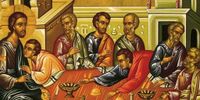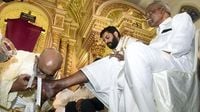Maundy Thursday, observed on April 17, 2025, is a significant day in the Christian calendar, marking the Last Supper of Jesus Christ with his disciples. This Holy Thursday is part of the Holy Week, which also includes Good Friday, Holy Saturday, and Easter Sunday. It is a time of deep reflection and commemoration of Jesus' teachings and actions during this pivotal moment in history.
The term "Maundy" is derived from the Latin phrase "Mandatum novum do vobis," meaning "a new commandment I give to you" (John 13:34). This commandment, which emphasizes love and service, encapsulates the essence of Maundy Thursday. On this day, Christians remember the institution of the Eucharist during the Last Supper, where Jesus shared bread and wine with his disciples, symbolizing his body and blood. As stated in 1 Corinthians 11:23-25, Jesus took bread and, after giving thanks, broke it, declaring, "This is my body, which is for you; do this in remembrance of me."
The Eucharist is central to Christian worship, representing not only a sacred meal but also a profound communion with Christ. During the service, believers partake of the bread and wine, which have been consecrated, reminding them of Jesus' sacrifice. This act of communion is a source of spiritual nourishment, allowing Christians to connect with the divine and reflect on their faith.
One of the most poignant rituals of Maundy Thursday is the washing of the feet, which recalls Jesus' humble act of washing his disciples' feet at the Last Supper (John 13:1-17). This act symbolizes servitude and love, emphasizing that true leadership is rooted in humility and service to others. During the evening mass, many churches conduct a foot-washing ceremony, where the priest washes the feet of twelve individuals from the congregation, mirroring Jesus' actions and reinforcing the call to love and serve one another.
In addition to the foot-washing ritual, Maundy Thursday also involves the preparation and consecration of holy oils for the coming year. This practice has been a tradition in the Roman Catholic Church since 1956, highlighting the significance of this day in the liturgical calendar. The morning liturgy often includes readings from the Old Testament, emphasizing God's covenant with His people, while the evening liturgy focuses on the institution of the Eucharist.
As Christians reflect on the events of Maundy Thursday, they are reminded of the profound love and sacrifice of Jesus. The day serves as a poignant reminder of the struggles faced by Christ, particularly in the garden of Gethsemane, where he prayed to his Father, expressing both his humanity and his unwavering commitment to fulfill God's will. In Mark 14:36, Jesus prayed, "Abba, Father, all things are possible to thee; remove this cup from me; yet not what I will, but what thou wilt." This moment of agony reveals the depth of his love and obedience, setting the stage for the events of Good Friday.
Judas Iscariot's betrayal of Jesus with a kiss is another critical aspect of Maundy Thursday, illustrating the complexities of human relationships and the darkness of betrayal. This act of treachery ultimately led to Jesus' crucifixion, a culmination of the ancestral sin that humanity grapples with. The juxtaposition of light and darkness on this day serves as a powerful reminder of the ongoing battle between good and evil.
In England, there is a unique royal tradition during Maundy Thursday, where the British monarch distributes alms to the poor and needy. This practice, which dates back centuries, symbolizes the spirit of service and charity that is central to the day's message. It connects the spiritual significance of Maundy Thursday with social responsibility, reinforcing the call to love and care for those in need.
As Maundy Thursday unfolds, many Christians engage in personal reflection and prayer. For some, it is a day of solemnity, while for others, it serves as a reminder of the hope and resurrection that follows the trials of Good Friday. Kyle Norman, a priest, shared a poignant experience from a Maundy Thursday in 2015 when he faced personal challenges. He reflected on how the Eucharist provided him comfort and connection to Jesus during a time of sadness and confusion. He expressed, "It was as if Jesus was telling my wife and me that all the confusion, discouragement, and dismay we were experiencing was the reason for his incarnation."
This sentiment echoes the heart of Maundy Thursday: that in the midst of darkness, Christ offers himself as a source of light and hope. The day serves as a reminder that struggles and discouragement do not diminish one's faith; rather, they can deepen the connection to the divine. As Christians reach out to receive Christ, they are reminded of his promise to be present in their lives, especially during difficult times.
In summary, Maundy Thursday is a day rich with history, symbolism, and spiritual significance. It invites believers to reflect on the love and sacrifice of Jesus, to embrace the call to serve one another, and to prepare their hearts for the events of Good Friday and Easter Sunday. As Christians around the world commemorate this sacred day, they are reminded of the enduring message of love, humility, and the transformative power of the Eucharist.









